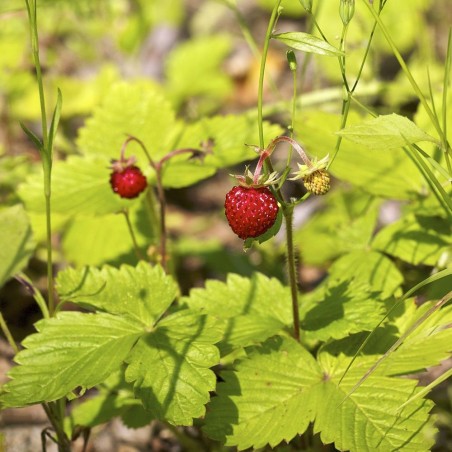





Fragaria vesca 'Rügen' is a variety of wild strawberry known for its small red fruits, highly aromatic and sweet in flavor. The plants are compact, making them ideal for cultivation in small spaces, such as pots or small gardens. This species is appreciated for its hardiness and ability to produce fruit continuously throughout the growing season. It is an excellent choice for home gardens, as it combines ornamental appeal with a generous production of high-quality strawberries.
A variety of alpine strawberry known for its hardiness and adaptability to different climatic conditions. Unlike common strawberries, this species produces small fruits with a highly concentrated flavor and an intense wild strawberry aroma. The plants, with their compact growth and trailing habit, form dense clumps that usually do not exceed 20-30 cm in height, making them perfect for garden borders, terraces, or balconies. Additionally, it is a perennial plant that can self-pollinate, which makes it easy to grow. Its bright green foliage and delicate white flowers make it an ornamental choice, ideal for combining functionality and beauty in small spaces.
Prepare a well-draining, nutrient-rich potting soil.
Fill pots or seed trays with the soil, leaving a 1-2 cm space from the top edge.
Spread the strawberry seeds over the soil surface, ensuring at least 1 cm of space between them.
Gently press the seeds with your hand or a board to ensure they are in contact with the soil, but do not bury them too deeply.
Cover the pots or trays with transparent plastic or a lid to retain moisture, creating an environment conducive to germination.
Place the pots in a warm location with indirect light, avoiding direct sunlight, as it can dry out the soil quickly.
Check the soil moisture regularly and water as needed to keep it moist, without letting it dry out completely.
The seeds usually germinate within a few weeks. Once the seedlings appear, remove the plastic or lid.
When the seedlings have developed two or three true leaves and are strong enough, transplant them into individual pots or directly into the garden.
| January | February | March | April | May | June | July | August | September | October | November | December |
Data sheet
No customer questions for the moment.